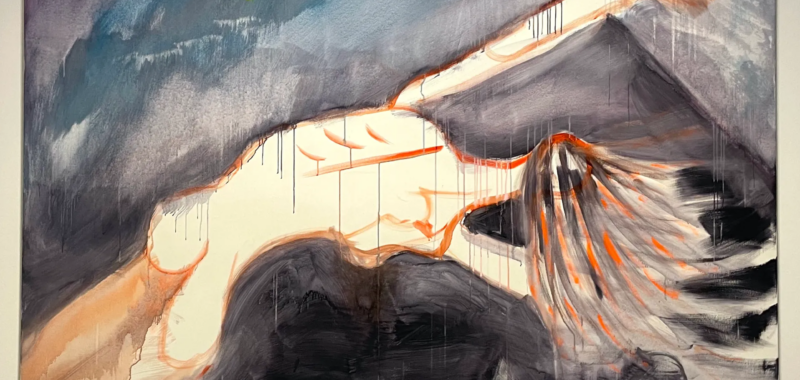VIENNA — Not long ago, Tamuna Sirbiladze was perhaps best known as the wife of Franz West. The Georgian artist, who died of cancer-related causes in 2016, shortly after her first New York exhibition, might not have minded: Sirbiladze and West, both artists, were partners in life and in art, collaborating on multiple projects. As good as those projects are, though, denying the artist her own spotlight is like burying a volcano.
Not Cool but Compelling at Belvedere 21, curated by Sergey Harutoonian with Vasilena Stoyanova, is a fitting title for Sirbiladze’s first institutional survey — an impressive overview that hopefully will lead to further exhibitions of her work. Organized into themed sections that follow a loose chronology, it starts with a small grouping of student works near the entrance, separated from the rest of the show by a room divider that acts as a slash between her youth in Georgia and her fuller artistic life in Vienna. The early works, mostly in dark colors, mired in modernist abstraction, hint at her art’s expressiveness, but they don’t prepare visitors for the wrenching intimacy and intensity that follow.

With a few smaller and more reserved exceptions, Sirbiladze painted big and wild — qualities that inevitably align her with the Viennese Actionists of the 1960s and ’70s and the German Neo-Expressionist artists of the 1980s and ’90s, given her location and cultural moment. And there is some affinity; one painting directly references Martin Kippenberger (“Kippi,” 2010) and all the artists in these groups provoked visceral responses with their work. Yet the show’s most striking pieces are those for which the exuberant physicality of her gestures coheres (sometimes just barely) into the female figure, in all of its simmering and explosive corporeality.
Among these paintings, two of the most distinctive are “Suicide Painting” (2007) and “Kotzen” (2005). Both center loosely rendered, almost cartoonish female forms: in the former, the woman leans backward, wide-eyed, a sharp diagonal behind her (or going through her); in the latter, she stands in a bathroom, vomiting into a sink, the tilted walls and red floor closing in on her. The image recalls Conrad Felixmüller’s shell-shocked 1918 print “Soldier in a Madhouse,” transposed onto women’s lives and bodily functions.

These two works are unique in their narrative and pictorial bluntness, and in Sirbiladze’s construction of the figures as characters whose actions and expressions are roughly readable, rather than unspecific bodies. The gut-punch of both should be undercut by the abjection and awkwardness of the scenarios, but instead they churn with the turmoil of life, like emotions sketched in real time.
The same raw feeling, filtered through an exacting artistic hand and mind to create a palpable visual effect, carries throughout the show. In “Tryangel” (2007), a figure sitting next to what looks like a syringe curls into a ball in the middle of another tilted interior, forming a spiral, while “Lenin’s Bulb” (2005) shows a nude, skinny woman floating in a dark gray space, a night sky or void. Other portraits comprise just a few rapid brush strokes, coaxing a figure from a flurry of gestural activity (as in the chaotic, unnerving “My Rapist” or the sparse, jittery markings of “When a Baby Was Pissing in Her Belly,” both from 2006). These images show people suspended between coming into being and losing themselves.

What makes the paintings so visually arresting is, in part, the artist’s attraction to color. In “Comme des Garçons, Odeur 53” (c. 2000), named for an avant-garde “anti-perfume” scent by the eponymous fashion line, Sirbiladze swaps the chill of postmodern critiques of capitalism for the heat of a saturated red canvas. An O shape (or toilet seat) containing a sketch of a toilet at the center, coupled with the red expanse, summons a host of associations with bodily fluids and functions. Also making bold use of red are the abstract “Concentrate on Metaphor” (2011) and “Loss of Garden” (2014), with their fire- and ruby- and blood-red unruliness.
Trauma is a touchstone in much art and culture today. Sirbiladze’s work clearly alluded to it, and some paintings can feel too personal or painful for public display. But the show is also a tribute to her artistic inspirations, from Warhol to van Gogh to Proust, and personal ones — her portrait of West and paintings of her children, and her final vast, meandering drawings looking back to her Georgian past, done in oil stick on giant, unstretched canvases. Not Cool but Compelling is like stepping into an artist’s interior world in all of its protean humanity. That Sirbiladze is not here to guide us through is a loss that will deepen as her art gets more exposure. But what remains is a force of nature.





Tamuna Sirbiladze: Not Cool but Compelling continues at Belvedere 21 (Arsenalstraße 1, Vienna, Austria) through August 11. The exhibition was curated by Sergey Harutoonian with assistant curator Vasilena Stoyanova.

